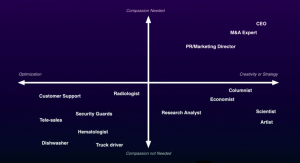Leadership is, at the heart of it, an action. And manifests most noticeably in the face of difficult situations. Which means it’s also mostly reactive. However, in today’s day and age, when the future is unpredictable, complexities are rife, and technology is changing faster than one’s ability to keep pace, leadership cannot solely exist as a reaction. Instead, the act of leading needs to centered on supporting the people in situations of today as well as tomorrow. Especially since industries and economies are finding themselves on the brink of technological upheaval at the hands of frontier tech like AI.
While there’s merit in believing that honing new-age skill sets will help keep pace with the new tech-enabled world, what leadership needs to be, now more than ever, is more human.
Qualities like the ability to relate, interpret and empathize will be the defining tenets of leadership with the dawn of the age of hi-tech. Employees across most modern organizations are already collaborating over complex tools, with cross border teams and on a broad range of tasks. Their success, then, depends not only on their skills, but their ability to judge, respond, and make decisions that align with business goals and values. Today, employees seek meaning and personal growth in their work, which is best addressed when leadership is relational and not technical. Which is why there’s little doubt, then, that the act of leading your people to success – business and personal – needs and will continue to need a human touch; now more than ever.
Leadership in the age of tech like AI
AI expert Kai Fu Lee writes about the close of the age of discovery in the world of AI and the dawn of the age of implementation. In his compelling TED Talk How AI can save our Humanity, Lee lays out a possible future of how humans and AI can coexist in the new world. Through an interesting graph, Lee plots the future of many careers and the possibility of AI taking those jobs over (see below). He predicts that over the next 5-10 years several routine and repetitive tasks, and as many as 40% of the jobs, will be completely taken over by AI in the next 15-20 years, leaving the more complex and creative tasks for humans.

This is the interesting thing to note: that AI, while likely to take over mundane, calculation-intensive jobs, is highly unlikely to take over jobs that demand softer skills like intuition and creativity. And the reason is quite simple: AI can’t feel.
If you see the graph plotted by Lee, you can note that CEOs occupy the top-right quadrant clearly indicating that this is one job that AI cannot do. Perhaps and likely because it requires the highest levels of creativity/strategy and compassion. This is quite telling of the fact that human leadership will stay relevant despite the arrival and dominance of AI because people will continue to want, in the foreseeable future, another human being as their leader.
The #1 quality that future leaders will want to hone
At the heart of great leadership is a trait that combines both compassion and creativity – empathy.
Empathy, by definition, is the ability of a person to be able to put themselves in someone else’s shoes (requiring imagination) and feel alongside them (requiring compassion). Studies show that empathetic leaders inspire loyalty and are most capable of bringing the best out in people because they are seen as trustworthy. As new-age workforce looks to leaders to help them navigate the tech-enabled complexities, volatile environment and dynamic teams, all the while helping them stay motivated and reminded of their big purpose, empathy will quickly become a leadership skill that new age leaders will have to master to stay relevant in the age of tech like AI.
Here’s how new-age leaders can hone empathy:
Understand Your Employees
Studies indicate that on average companies around the world spend about a trillion dollars a year trying to understand customer behavior. In stark contrast, they spend a thousand times less on understanding employee behavior – their needs, their pain points and how their journey with their employer can be made more satisfying. In fact, organizational behavior expert Diana Dosik says business leaders confess to spending less than 5% of their time trying to understand what their employees do and why they do it. And while companies try to engage their employees through various other initiatives, they completely overlook the importance of understanding employee behavior.
AI-enabled tools now exist that can come alongside a leader and show them insights into their employees’ behavior and its effect on the employee’s performance and productivity. A leader who is able to go the extra mile to understand the pain points and motivations of his/her employees will also be able to find ways to drive employee performance and engagement and bring lasting benefits to the organization as well as its employees.
Empower Your Employees
A study conducted by PwC, involving more than 4000 millennial employees across 75 countries, explored work benefits that millenials valued most. More than a company car, financial assistance with housing, vacation allowances, and even healthcare benefits, most employees said they valued training and development.
That’s not very surprising considering that millennials view work in a fundamentally different way from their predecessors. For the baby boomer generation, work was a reward in itself. Millennials, on the other hand, look for purpose and meaning in their jobs. It is no wonder then that they value training and development as it gives them the tools to be more effective and valuable to their places of work.
Leaders who see the value of such a mindset can empower employees through meaningful mentorship and coaching. In turn, and more importantly, they will be building a more capable, effective, engaged and loyal team that can benefit their organization for the long run.
Be Available to Your Employees
Managers and supervisors engaging and communicating through digital platforms tend to lose out on the benefits of a one-on-one conversation. Studies have shown that written communication often leads to misunderstandings because words don’t always capture our emotions and attitudes.
Leaders of organizations, then, need to lead the pack by taking the time to meet their team one-on-one in order to create a communicative and warm culture.In 2017, a study reported in Harvard Business Review showed a strong link between the one-on-one time employees received from their manager and their engagement levels. Employees who engaged in twice as many one-on-ones with their manager were 67% less likely to be disengaged. More strikingly, when managers didn’t conduct any one-on-one, employees were four times more likely to be disengaged as individual contributors.
The essence of leadership is human
The time has come for leadership to be optimized to meet the needs of workers now and workforce of the future – where the locus of leadership lives within a human context and less around skill sets. Business leaders who can master the relational skills like empathy will find that they are not only relevant but crucial to creating successful companies in the age of automation. And AI’s real power will be unleashed as it frees up humans to be creative and compassionate leaders.
Image Credit: Photo by Cytonn Photography on Unsplash


